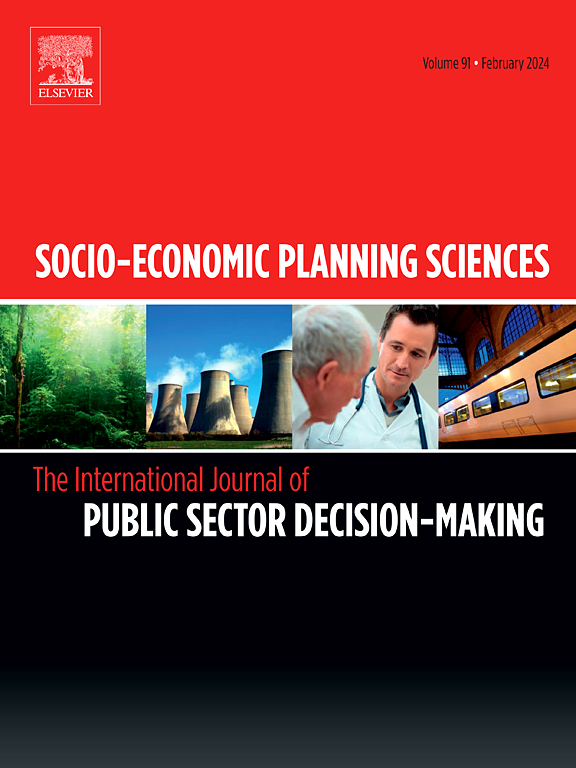在地理空间中表现社会排斥:可解释性还是信息力量?
IF 5.4
2区 经济学
Q1 ECONOMICS
引用次数: 0
摘要
社会排斥是一个复杂的、多方面的现象,理解它需要同时考虑经济、教育、家庭和环境方面。在这种情况下,复合指标通过一维测量同时考虑社会排斥的多个方面,从而有助于理解社会排斥。可以使用多种方法构建复合指标,包括主成分分析,这是最流行的方法之一。然而,该方法存在信息丢失和可解释性等局限性。当多维现象方面缺乏相互关联时,信息丢失可能会很严重。在这种情况下,必须同时考虑多个主成分,以理解多维现象,重新点燃复合指标试图解决的可解释性问题。本研究提出一种新的方法来平衡主成分分析所建构的复合指标的资讯力与可解释性。研究表明,信息损失不仅受到低相关性的影响,还受到信息多样性和与概念显著指标的相关性的影响。这些发现表明,忽略传递低信息的相互关系差的方面并不会缩小其概念范围,但会确保更大的信息力量和可解释性。特别是,所开发的方法在第一主成分中有效地捕获了具有令人满意的信息力量的社会排斥概念。主成分分析和地理加权主成分分析需要三个主成分才能获得令人满意的信息权力,从而损害了社会排斥的可解释性。研究结果指出,采用主成分分析构建复合指标的新做法具有相关性,其中可解释性和信息能力是平衡的。本文章由计算机程序翻译,如有差异,请以英文原文为准。
Representing social exclusion in geographic space: interpretability or informational power?
Social exclusion is a complex, multidimensional phenomenon, and its understanding requires simultaneously considering economic, educational, household, and environmental aspects. In this context, composite indicators facilitate understanding social exclusion by simultaneously considering its multiple aspects through a one-dimensional measure. Composite indicators can be constructed using numerous methods, including Principal Component Analysis, one of the most popular. However, the method has limitations, such as information loss and interpretability. Information loss can be substantial when the multidimensional phenomenon aspects are poorly intercorrelated. In this situation, numerous Principal Components must be considered simultaneously to understand the multidimensional phenomenon, rekindling the interpretability problem that composite indicators pursue to solve. This study develops a novel approach that balances information power and interpretability in composite indicators constructed by Principal Component Analysis. The study reveals that information loss is not influenced solely by low intercorrelation but by information diversity and correlation with a conceptually significant indicator. These findings indicate that disregarding poorly intercorrelated aspects that transfer low information to the composite indicator does not diminish its conceptual scope but ensures greater information power and interpretability. In particular, the developed approach effectively captured the concept of social exclusion with satisfactory information power in the first Principal Component. Principal Component Analysis and Geographically Weighted Principal Component Analysis need three Principal Components to achieve satisfactory information power, compromising the social exclusion interpretability. The study findings point to the relevance of adopting a new practice of constructing composite indicators through Principal Component Analysis in which interpretability and informational power are balanced.
求助全文
通过发布文献求助,成功后即可免费获取论文全文。
去求助
来源期刊

Socio-economic Planning Sciences
OPERATIONS RESEARCH & MANAGEMENT SCIENCE-
CiteScore
9.40
自引率
13.10%
发文量
294
审稿时长
58 days
期刊介绍:
Studies directed toward the more effective utilization of existing resources, e.g. mathematical programming models of health care delivery systems with relevance to more effective program design; systems analysis of fire outbreaks and its relevance to the location of fire stations; statistical analysis of the efficiency of a developing country economy or industry.
Studies relating to the interaction of various segments of society and technology, e.g. the effects of government health policies on the utilization and design of hospital facilities; the relationship between housing density and the demands on public transportation or other service facilities: patterns and implications of urban development and air or water pollution.
Studies devoted to the anticipations of and response to future needs for social, health and other human services, e.g. the relationship between industrial growth and the development of educational resources in affected areas; investigation of future demands for material and child health resources in a developing country; design of effective recycling in an urban setting.
 求助内容:
求助内容: 应助结果提醒方式:
应助结果提醒方式:


